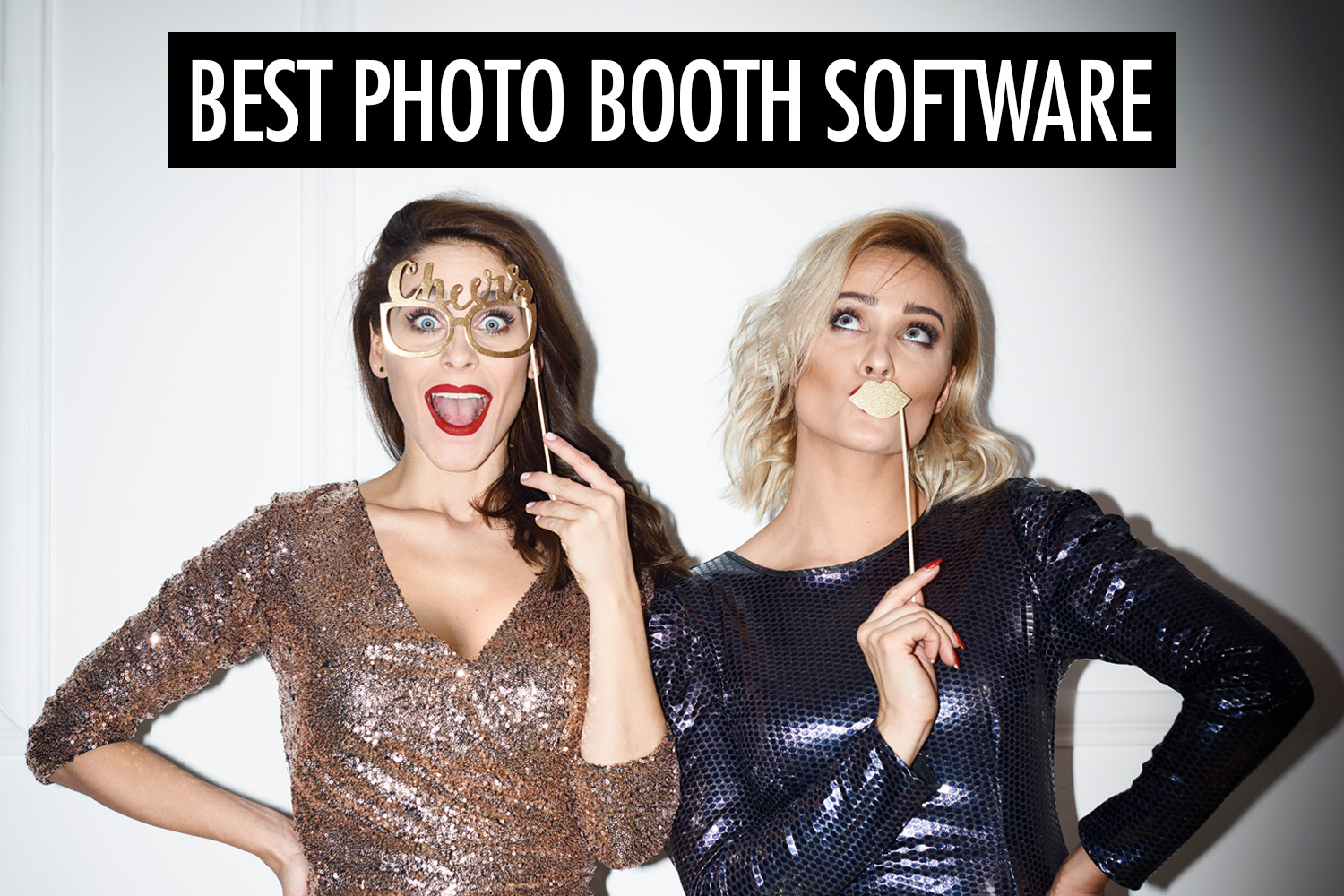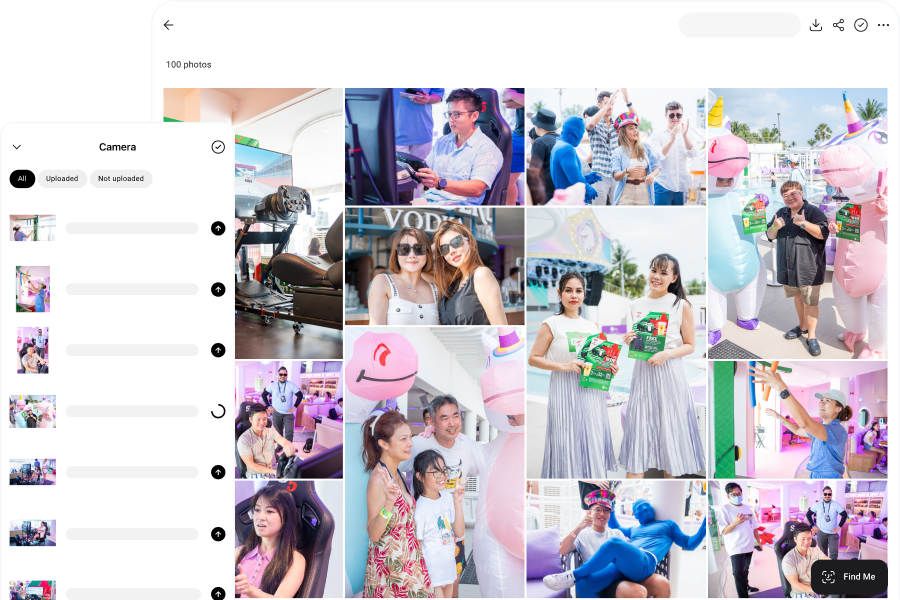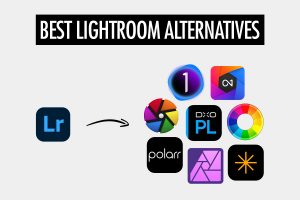Photo booths have been a staple at events for a long time, and understandably so. They are an amazing way to provide entertainment for your guests, and bring groups of people together for a social activity. The resulting photos and prints are also meaningful keepsakes for your guests.
If you’re running a photo booth, you will understand that the photo booth software can make or break the experience. You want software that can perform reliably when you’re taking a large number of photos. It should also offer a few key features that are expected from any photo booth, such as instant sharing, custom borders to brand the photos, an easy way to manage prints, and live slideshows.
In this article, we’ll walk you through the 13 best photo booth software that you can buy today. There are two main categories for photo booth software—running either on Windows or iPads. We’ll cover options from both categories and talk about their pros and cons.
Why should you listen to us? Because we’ve been running our own photo booth and event photography company (at Ubersnap) since 2016. When it comes to photo booths, we know our stuff.
Honcho
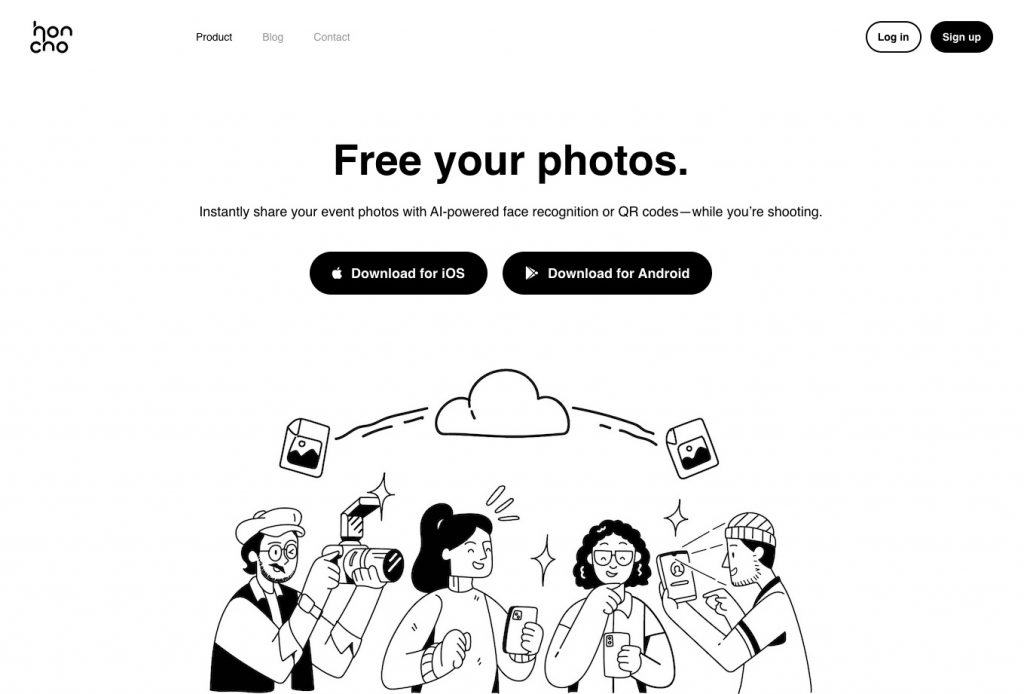
Honcho helps photographers instantly upload and share their photos with clients and guests, while they shoot—creating an amazing experience for events, weddings and high-volume headshot sessions. While it’s designed with photography in mind, it can also be used for photo booths. After all, you can think of photo booths as photographers who stay in one spot (while providing a backdrop and props), instead of roaming the venue.
Honcho is available on all platforms—iOS, Android and web—and can be used on any device. Since it’s cloud-based, you can set up your event on any device and it will be synced across all the other devices, making it easy to manage your events.
Here’s how Honcho works. First, it lets you upload your photos from camera to cloud, while you shoot. This is done by tethering your camera to your smartphone, with the Honcho app installed. The photos are automatically transferred to the app and uploaded to the cloud, and they can be instantly viewed in an online gallery.
After uploading, you can instantly apply editing presets or have an assistant edit the photos with the built-in collaborative photo editor. This makes it possible to deliver polished edits in just seconds.
You can share your photos in two ways—AI-powered face recognition or QR codes. For face recognition, your guests will just upload a selfie, and Honcho will automatically find their photos by matching them with the selfie.
Honcho helps you earn more from every event by selling your photos. And because the photos are delivered live, at the height of the excitement, you capture sales when guests are most eager to buy. Everything runs automatically while you shoot—just add an online store with one click and make your gallery instantly shoppable.
Honcho gives you full control over privacy. It lets you password protect the online gallery, so that only selected people have access to it.
Alternatively, you can blur all of the photos in the gallery. Only photos that are found with face recognition are unblurred, which means you can only see your own photos and no one else’s. Hence, you can freely share the online gallery, while maintaining everyone’s privacy.
In addition, Honcho lets you add custom borders to the photos, create live slideshows and print wirelessly, all from a single platform. Again, you can manage your events from any device and work in teams, with all of the photos and settings synced up automatically.
Many photo booth companies provide photography services too, because there are events and weddings that require both services—it’s just a common sense way for these companies to diversify their services. The opposite is also true—many photographers also end up offering photo booth services.
Honcho is the only software on this list that’s flexible enough to do the job for both. For event and wedding photography, it lets you instantly upload and share your photos, while still roaming the venue freely (in some places, it’s called roaming photography or roaming photo booth). For photo booths, it provides a system that’s easy to set up and reliable to use, and includes all of the key features that are important for a good photo booth experience.
Sign up for a free Honcho account today and see how it can transform your photo booth or photography business.
In addition, you can join our affiliate program and earn up to USD$88.50 for every new customer that you refer to us. That’s a generous commission!
dslrBooth
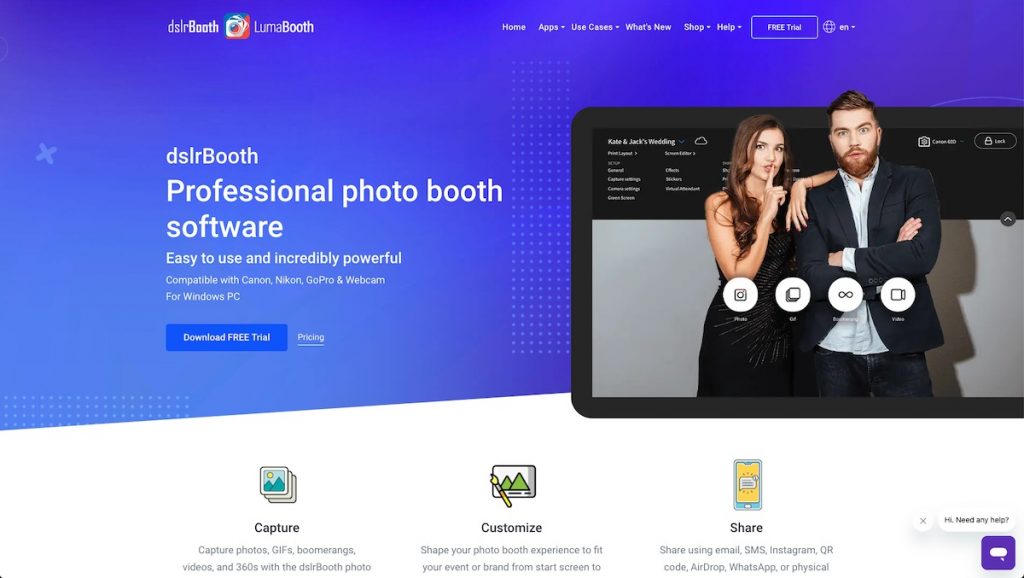
dslrBooth is a versatile photo booth software that runs on Windows, and it can be used to provide a variety of experiences, from the standard photo booth to the 360 booth. It can connect with DSLRs, and Canon and Nikon mirrorless cameras.
All photo booth software have essentially the same workflow, and dslrBooth is no exception. You start a countdown, take a photo, let guests download the photos by scanning a QR code or entering their contact information (email or phone number), and choose how many copies to print. Then you start all over again for the next group of guests.
dslrBooth provides a good balance between ease of use and flexibility. It’s relatively painless to set up an event, and it supports a wide range of requirements—such as green screen photo booths or video guestbooks. You can customize the screens and print templates, add custom borders, and share the photos with email, SMS or QR code.
dslrBooth also supports 360 booth setups, allowing you to deliver cinematic, slow-motion videos using rotating platforms and compatible cameras. This makes it a solid option for events that want a more immersive and dynamic experience. In addition, the software includes an AI background remover, which lets you replace backgrounds without needing a green screen. It’s ideal for creating clean, professional-looking images even in tight or unprepared spaces.
In summary, dslrBooth is a versatile photo booth software that can cover most use cases. If you’re looking to offer different types of experiences, it’s a good all-in-one solution.
Darkroom Booth
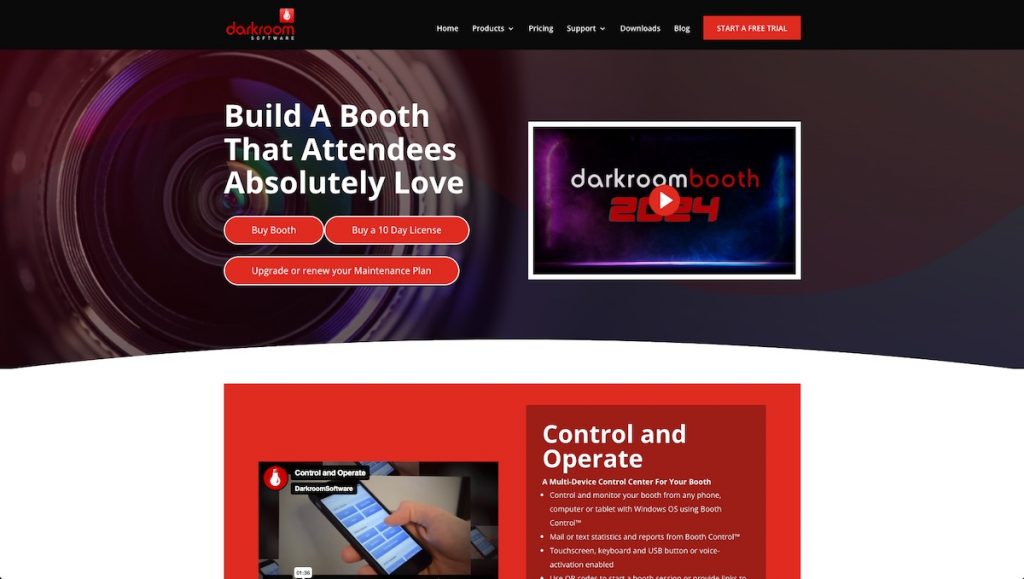
Darkroom Booth is one of the oldest players in the market, and it shows in their photo booth software. It’s packed with a huge number of features and customization options, almost like Photoshop for photo booths.
But like Photoshop, it comes with a steep learning curve. It can be difficult to troubleshoot because of how complicated it can get—fortunately, they provide plenty of learning resources and have a responsive customer support team.
The flip side is that it has just about every feature you can think of, and many features that you never thought to have. This is useful because over time, you will encounter clients with special requests. Chances are Darkroom Booth can support that unique requirement.
Recently, Darkroom Booth has also expanded into AI-powered features. You’ll find tools like generative AI effects, AI face swap, AI-generated design templates, and AI-based custom filters that allow you to quickly offer a wide range of unique experiences. It also supports 360 spin booth setups, giving you the flexibility to offer immersive and cinematic event experiences.
Darkroom Booth runs on Windows, and you will have to set up the event and run the photo booth on the same device. It works on a one-off license, which means that you can purchase the software outright. When new versions come out, they offer upgrades at discounted prices.
Breeze Systems
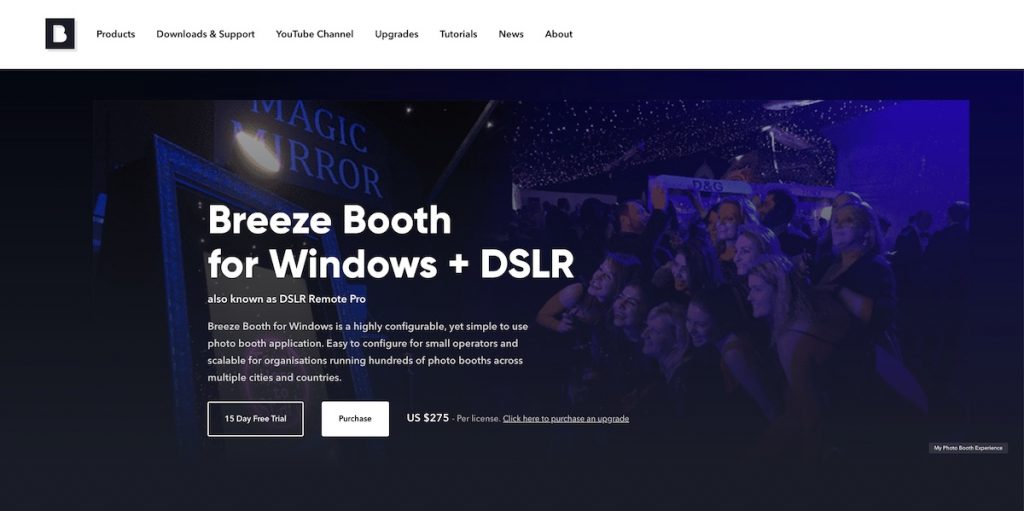
There are different versions of Breeze Booth for different configurations—Windows + DSLR, Windows + Webcam, and iPad or iPhone.
Generally, iPad-based photo booths are easier to manage than Windows-based booths, for a couple of reasons. iPads are usually more reliable than Windows devices and easier to keep up to date. The last thing you want is for your Windows booth to install an update in the middle of an event—which has happened to us! iPad-based photo booth software also tends to be simpler than Windows software, so you’re trading flexibility and customization for ease of use.
Regardless of the version you choose, you will get the expected features with Breeze Booth—customization options, different experiences from GIFs to green screens, and instant sharing via email or SMS.
For those looking to incorporate AI-powered enhancements, Breeze FX adds another layer of creative flexibility. It includes advanced tools like head extraction, face swap, cartoon-style filters, and AI background removal—all processed locally without needing an internet connection. These effects can help you deliver more engaging and customized outputs, especially for branded events or themed activations.
On top of that, Breeze Booth also supports 360 booth setups, allowing you to create dynamic, rotating video experiences when paired with compatible hardware. It’s a great way to elevate your offering if you want to move beyond static images and deliver cinematic content on the spot.
The unique feature that only Breeze Booth offers is the ability to integrate with third party software, via auto hot key scripting and accessing data via XML. If these terms mean something to you and you have the technical expertise, you can use Breeze Booth as the base to build custom solutions.
Snappic
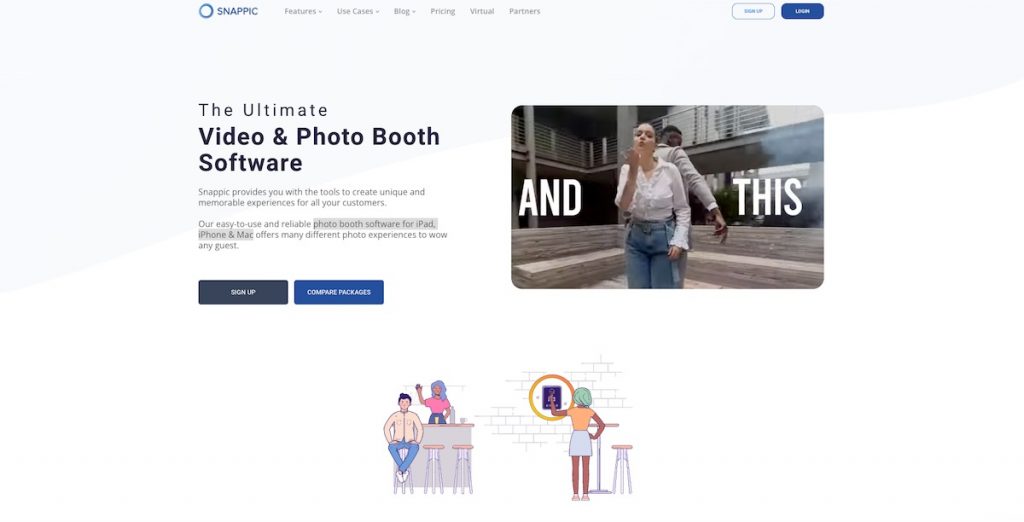
Snappic offers photo booth software for the iPad and iPhone. You’re not just restricted to using the iPad or iPhone camera—you can connect Canon and Nikon cameras with a USB connection. Obviously, this is important if you care about image quality.
With Snappic, you can create a variety of experiences with just your iPad—from the standard photo booth to boomerang or video booths.
The team behind Snappic is usually good at staying on top of the latest trends, and pushing new features as the technology becomes available. One of Snappic’s biggest strengths lies in its AI-powered features. Its AI-FX suite includes a range of tools such as face swap, personalized visual effects (PersonaFX), and creative filters that transform the user experience. It also offers AI Photo Glam, which automatically enhances photos for a polished, professional look.
For content delivery, Snappic’s AI Sharing uses facial recognition technology where guests simply take a selfie, and the system automatically finds all the photos featuring their face, making the retrieval process quick and seamless. On top of that, Snappic supports 360 booths through its VideoFX feature that allows you to create high-quality, cinematic video edits with built-in motion effects and templates, all within the app.
That said, Snappic comes at a rather hefty price tag. It’s one of the most expensive options on this list, and its pricing makes it accessible for only the more established photo booth companies. It’s a good option if you’re looking to create a more unique experience with their latest features.
Simple Booth
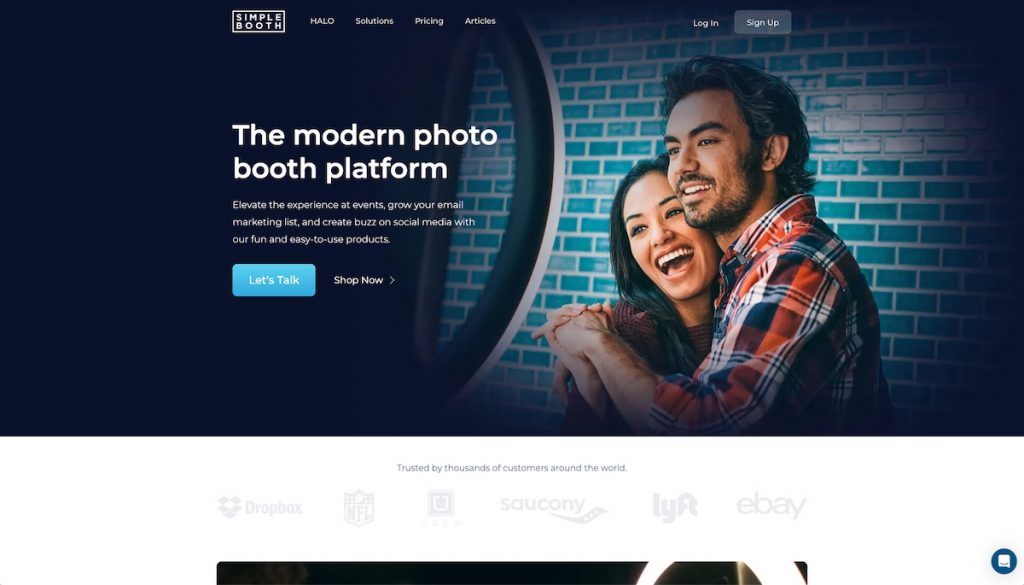
This is a case where a company’s positioning can be found in their name. Simple Booth offers an iPad-based photo booth software that is simple to use. It also sells physical hardware called HALO, which is essentially a sleek photo booth shell for your iPad, with an integrated ring light. However, you can use their software without purchasing their hardware.
Simple Booth’s ease of use comes from not offering too many features. It provides the standard photo or GIF experience, the option to instantly share the images via QR code, and forms to collect user information. Unfortunately, it doesn’t support external cameras, and you have to use the iPad camera. If image quality is important to you, this could be a deal breaker.
Simple Booth has also introduced AI-powered virtual backgrounds, allowing users to replace the original background without needing a green screen. This is particularly useful for casual environments or venues where setup space is limited. It adds a layer of customization while keeping the experience simple and accessible for both operators and users.
Simple Booth’s target market isn’t just photo booth companies, but also businesses that want to install a photo booth at their venues—for example, at retail stores, restaurants and bars. Hence, their limited feature set becomes their strength, because their photo booth software is easy to set up and operate. However, if you’re looking for a more robust set of features and customization options, the other options on this list will serve you better.
Foto Master
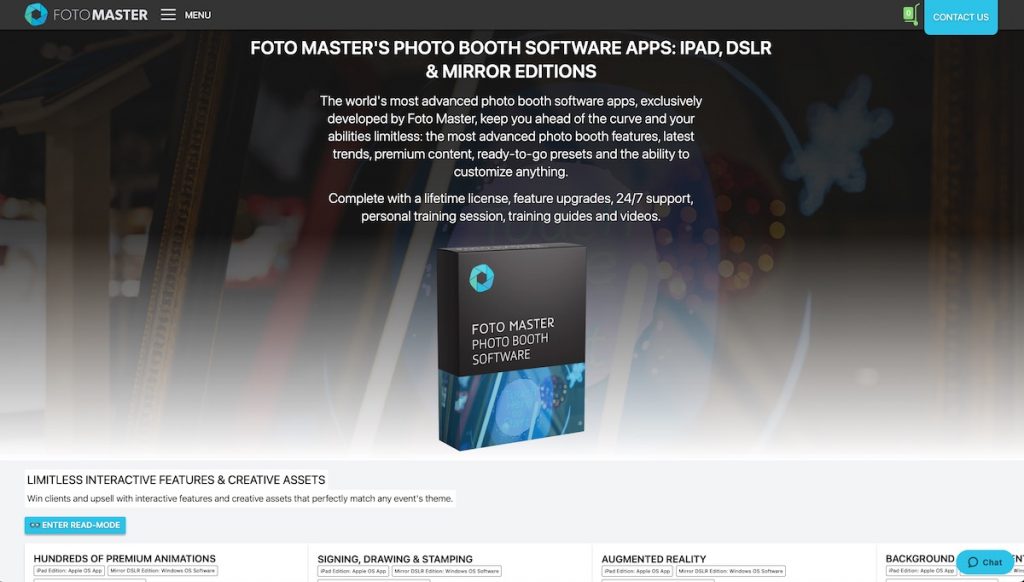
Like Darkroom Booth, Foto Master is one of the oldest players in the photo booth market, and they offer both hardware and software solutions.
For their photo booth software, they have different editions for iPad and Windows. They offer a huge range of features, such as augmented reality, hair color replacement and even interactive games like tic-tac-toe. Some of these features are only offered by Foto Master, so if you have a unique requirement, they might be the only option that supports it.
Foto Master also offers powerful Cloud AI tools that bring a new level of creativity to your events. You can apply instant face swaps, perform seamless AI background removal, and even generate playful AI cartoons and custom filters via the cloud without needing manual editing or green screens. Their AI Headshot feature allows custom styles (from realistic to artistic themes) using prompts, and it integrates directly into their workflow to automatically replace the original photo with the AI-produced version. This Cloud AI package enables additional creative options like template generation and prompt-based theming, while still supporting immersive 360° spin booths.
Learning how to use their software can take time and feel overwhelming, but there’s a good chance that this is the only photo booth software you will need to support all of your events. However, if you’re looking for a solution that is easy to learn and set up, there are better options on this list.
Foto Master sells their software with a lifetime license, which means you’ll just have to make a one-time investment.
Social Booth
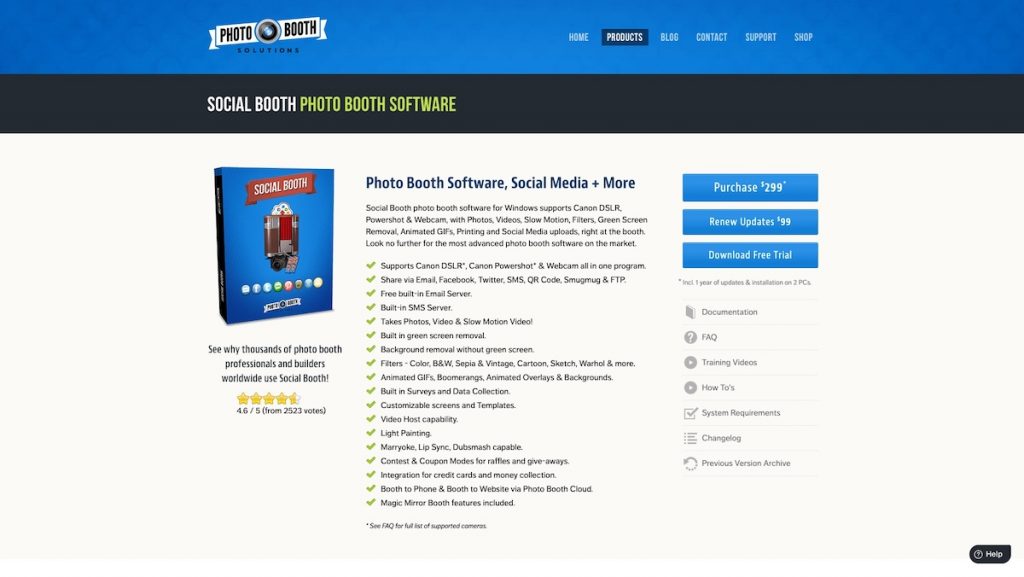
Social Booth (by Photo Booth Solutions) is a Windows-based software with support for Canon DSLRs and webcams. Its pricing is based on a license which includes one year of updates and installation on two separate PCs. After a year, you can purchase updates at a discounted price.
Social Booth offers a fairly wide range of features. It can support standard photo booths, GIF booths, video booths and mirror booths. You can customize the user interface and create custom templates for the photos and prints.
It offers a couple of unique features, the first of which is a “video host”. Essentially, you can record a video which you can play on the screen to cue your guests. For example, the video can show a photographer providing posing instructions, before automatically triggering a countdown. The second unique feature is the karaoke photo booth, which lets you record lip sync videos.
Social Booth also includes a suite of AI-powered effects that enhance the guest experience with minimal effort. These features include AI background removal, cartoon effects, and advanced filters like AI aging and face transformation. What makes this especially useful is that these effects can be applied instantly, without requiring a green screen, making setup much simpler. Whether you’re aiming for fun, polished, or futuristic outputs, these AI tools allow you to elevate the final image while keeping the workflow streamlined.
SparkBooth
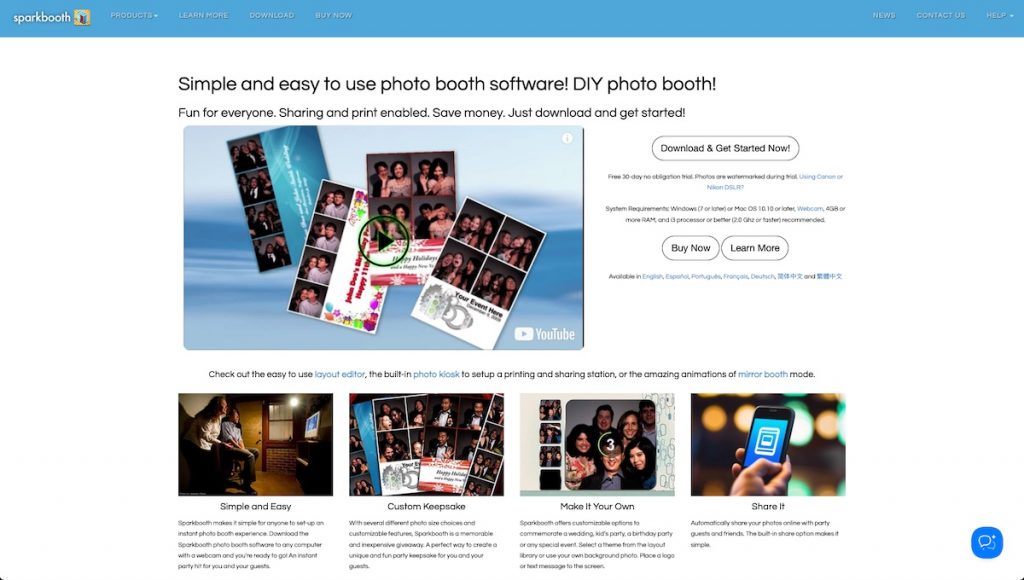
SparkBooth offers photo booth software that can be run on Windows and Mac, and it’s compatible with Canon and Nikon DSLR cameras. Compared to the other options on this list, it has a relatively limited feature set, but that’s offset with its comparatively low price—it offers a lifetime license at a lower price point than the other options.
With SparkBooth, you can take still photos or GIFs, sign and draw on the photos or apply digital stickers, instantly share the photos via email, add custom borders and create print templates. While SparkBooth doesn’t have built-in AI effects like some of the more advanced platforms, it does support AI-powered background removal through integration with third-party services such as PhotoRoom, Removal.ai, Remove.bg, and Slazzer. By connecting your own API keys, you can offer clean, professional-looking photos without needing a green screen—something that’s especially helpful in tight event spaces or quick setups.
It’s a good option if you’re just starting off or only planning to provide the standard photo booth. For example, if you’re a photographer and you’re looking to add on a photo booth service, this could be a good option to explore.
RightBooth
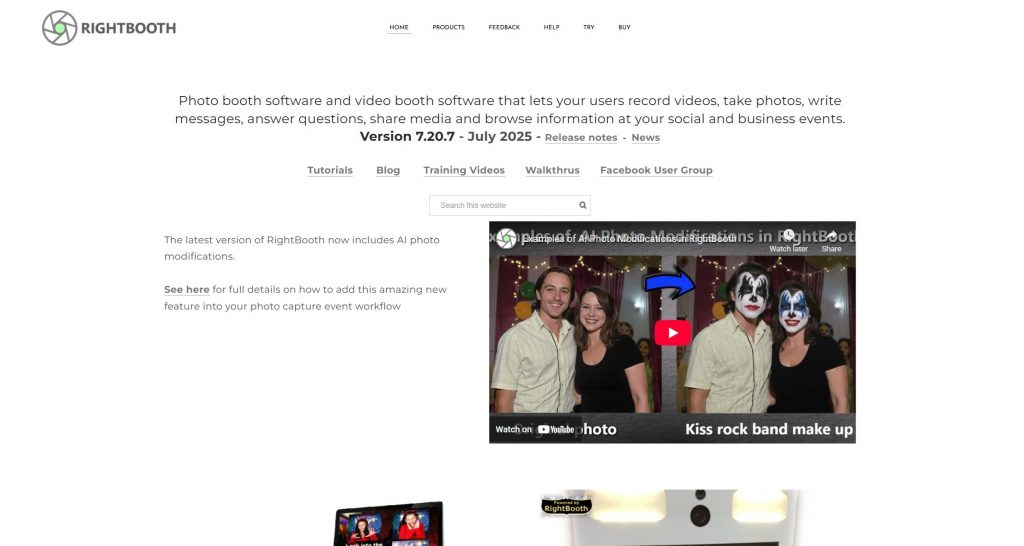
RightBooth is a Windows-based photo booth software that gives you a lot of flexibility, especially if you’re looking to run more unique experiences like 360 booths. It supports a wide range of camera options, including webcams, Canon and Nikon DSLRs, and GoPros. With the right hardware setup, you can use RightBooth to power a 360 booth and deliver slow-motion videos with overlays and effects.
Where RightBooth stands out is in how much you can customize your booth experience. You can design every screen your guests interact with, create unique workflows, and tailor the event down to the smallest detail from animated overlays to multi-camera angles.
One of its newer features is AI-powered photo enhancement. You can automatically replace backgrounds, perform face swaps, and apply creative modifications to photos using simple text prompts. These AI tools help elevate your booth output without needing much manual editing, and they can be a huge draw for guests looking for something a little different.
Touchpix
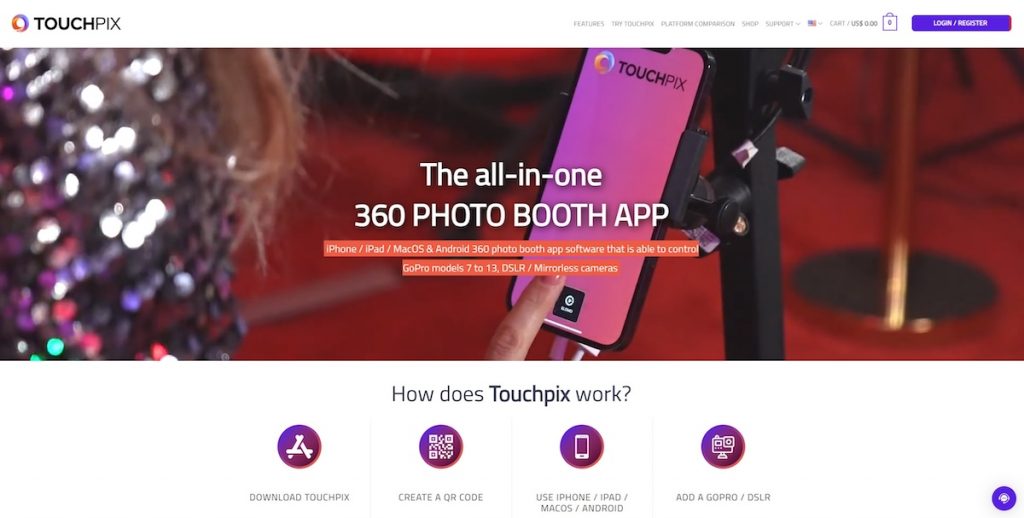
Touchpix is a feature-packed photo booth software that’s targeted mainly at 360 booths, making it one of the best options if you’re offering slow-motion video experiences. It supports a wide range of devices—including iPads, Android tablets, GoPros, DSLRs and webcams—and can run on multiple platforms like iOS, Android, Windows and macOS. This gives you a lot of flexibility when it comes to your hardware setup.
That said, you can also use Touchpix to create a variety of experiences: from standard photo booths to boomerangs, GIFs, and full 360 video booths with slow motion and custom effects. It supports automatic background removal using AI, which means you don’t need a green screen. Some of its newer AI features include face swapping and creative effects that can be triggered with simple text prompts, which are great for making your booth content feel fresh and unique.
Touchpix is especially strong when it comes to sharing. It allows you to share content via QR code, SMS, email, WhatsApp or social media—even if you’re offline. The content gets queued and is sent out automatically once you’re back online, which is incredibly useful for venues with poor internet connectivity.
If you want to collect emails and phone numbers from your guests, Touchpix makes that easy too. It saves all the data, which you can download later as a spreadsheet. You can also print photos using any compatible printer, directly from the app.
Touchpix works on a subscription model, with different pricing tiers depending on how many devices you want to use and how long you need it for. While it’s not the cheapest option out there, it’s packed with features and provides excellent value, especially if you’re offering 360 booths or want to use AI-powered tools.
Fiesta
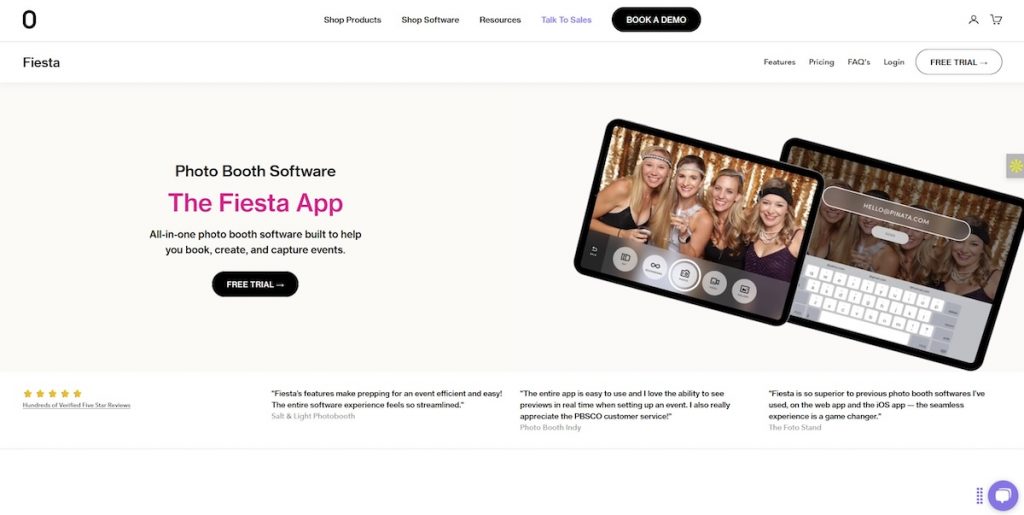
Fiesta is a modern, all-in-one photo booth software designed to help you book, run, and manage events, all within a single platform. It works on iPhones, iPads, and offers web-based design tools, making it flexible for mobile or desktop setups.
You can capture a full range of media such as photos, GIFs, boomerangs, videos, and full 360° slow-motion clips. It also includes AR filters, green screen, glam effects, and face masks. The software offers built-in stabilization and royalty-free soundtracks for 360 booths, along with pre-built video templates and automatic capture triggers, which are ideal for streamlined 360 booth experiences.
Fiesta includes business tools like a proposal builder, portfolio website, analytics, email capture, and survey data to help you manage both bookings and operations with ease. You can also print photos on the spot using AirPrint or wired printers connected to iPads.
Sharing options are versatile. Guests can instantly send images via email, SMS, QR code, or AirDrop. Offline Mode ensures everything queues up and sends automatically once internet connectivity returns.
AI Photo Booth Pro
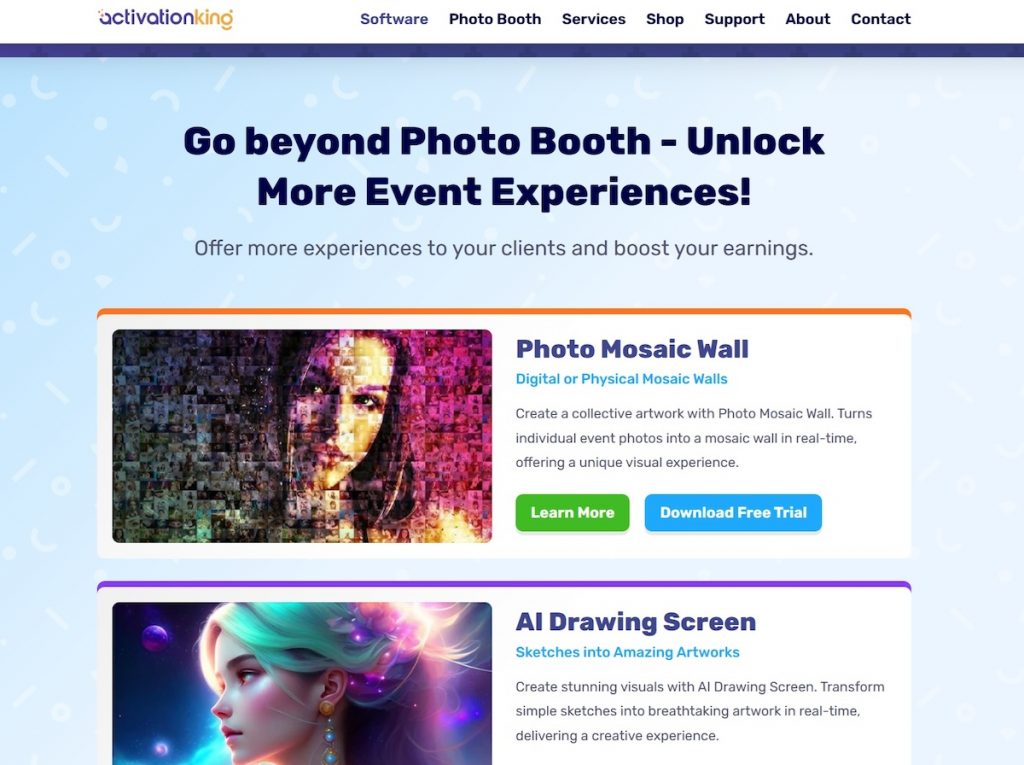
Activation King’s AI Photo Booth Pro is a robust software solution built to elevate any event with powerful AI features. It goes beyond standard photo booth functions by offering AI background removal, face swapping, and impressive generative AI tools that allow you to create custom photo prompts. One of its standout innovations is the cutting-edge AI motion technology, which adds dynamic movement effects to your captures for a more engaging experience.
The platform also supports all the classic photo booth essentials. You can customize templates, take photos, print them on the spot, and enable instant sharing. For those looking to deliver more cinematic experiences, the software is compatible with DSLR cameras and GoPros which is perfect for creating immersive 360° video content.
Sharing options are just as versatile. Guests can receive their photos through email, SMS, instant QR codes, or social media. AI Photo Booth Pro is one of the more affordable platforms offering AI-powered effects. While it’s limited to Windows and runs on a credit-based AI system, it delivers a lot of creative potential for event pros looking to impress their guests.

